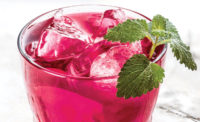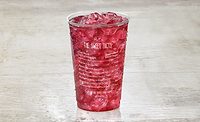Beverages On Display
By JENNIFER KOROLISHIN
Point-of-purchase materials reinforce branding
After pouring millions of
dollars into advertising and promotions, beverage companies’ moment
of truth occurs at retail, where consumers are faced with choosing from
hundreds of brands.
That reality makes point-of-purchase materials a
critical part of beverage marketing strategies.
“The war is really going to be won at the store
level,” says John Woods, director of sales for Display Industries, a
Norcross, Ga.-based provider of stock and customized point-of-purchase
displays. “Studies show that consumers make a buying decision in as
few as five seconds when they’re in front of your category. You
don’t have someone’s attention very long in order to make an
impact.”
Beverage P.O.P. materials take various forms, from
permanent displays — typically metal shelving or end-caps — to
semi-permanent displays made from injection-molded plastic or corrugated
materials, to signage used everywhere from outdoors to cooler doors. Often
used to support new product rollouts, P.O.P. is increasingly part of
multi-brand strategies, as displays can be designed to hold multiple types
and sizes of product.
“We’re seeing a shift from permanent
displays to semi-permanent,” Woods says. “With the
proliferation of new brands, shelf space is getting pretty tight, so
secondary and tertiary displays are becoming quite popular, many of which
are semi-permanent in nature,”
Signage is also a large component of P.O.P. efforts,
particularly for the soft drink category and the convenience store channel,
where outdoor signage is used to bring customers into the store, and cooler
door signage encourages single-serve consumers to select specific brands.
“One of the trends
in signage is applying technology to create light and movement,” says
Bobbie Shosty, marketing director for May Advertising, a Fort Worth,
Texas-based screen printer and metal sign fabricator. “We’re
launching a decal with LED technology inside of it. You can apply it to the
cooler door and it flashes to get the consumer’s attention.”
P.O.P. placement varies by channel. Grocery stores are
branching out beyond the beverage aisle, spreading P.O.P. throughout the
store. Convenience store P.O.P. tends to focus on the cold vault. It is
also appearing more often in drug stores as that channel expands its
selection of convenience and grocery products. In all channels, P.O.P.
placement depends on the floor space granted by the retailer.
“There have been many studies showing that if
you take a product off the shelf and move it into a display in the same
aisle, it increases your sales,” says David May, national accounts
manager for Florence, Ky.-based Lingo Manufacturing Co. Inc., which designs
and manufactures custom permanent P.O.P. displays. “If you move it to
the end of an aisle, it increases sales even more, and if you can place it
by the register or another secondary location, you’re adding to the
potential sales lift.”
As beverage industry competition intensifies, P.O.P.
manufacturers are developing innovative ways to draw consumer attention
before the point of sale. “These newer types of P.O.P. are a way to
call attention to your product because, let’s face it, when somebody
goes to the cooler to buy a bottled water, how many people are focused on a
specific brand?” says Gil Aviles, co-founder of Kent, Conn.-based
Crew Design Inc., which designs and produces P.O.P. advertising displays,
signage and fixtures. “If you have something that’s really
calling attention to your brand, you have a good shot at getting the
sale.”
To that end, Crew Design released its
“Visistrobe” product last year to promote single-serve
beverages. Created originally for Mountain Dew, Visistrobe contains a
battery-operated infrared sensor. Placed inside the cooler, it detects
motion and triggers a blinking light that makes the beverage appear to
glow.
Brand and category play important roles in the type of
P.O.P. beverage-makers choose. Soft drink companies tend to focus more on
signage, while wine and spirits companies, with lower volume and higher
price points, are more inclined to invest in permanent and more elaborate
displays. For example, Lingo Manufacturing recently created a
Whaler’s Rum display that incorporates a surfboard look, reflecting
the brand’s tropical image.
In choosing P.O.P., beverage-makers balance
practicality with marketing factors. While signage and displays are meant
to reinforce a brand’s message, P.O.P. must also be durable and
appropriate for conditions. “The first question our salesperson will
ask a client is ‘What’s the application? Is it outdoor, indoor,
permanent, semi-permanent, temporary?’” Shosty says.
Budget constraints are also taken into account in
deciding on P.O.P. strategy and execution. “When it comes to our
beverage business, cost is always an issue. We
design around cost,” Aviles says. “A lot of the products we
produce, like our pop-up line, ship in very small boxes because often with
big displays, people are paying more to ship the units than they are for
the actual unit.”
As new beverage brands proliferate, P.O.P. will
continue to play a key role for a number of reasons. “One thing
displays do is they really increase impulse buys. The other thing is that
you spend all this money on other advertising, but you get the most bang
for your buck at the point of purchase,” May says. “A nice
display does a couple of things for you. It brings attention to the
product, and it gives consumers the impression that it must be a premium,
reputable brand to have its own space in the store. It says something about
how you’re investing in your product.”
BI





